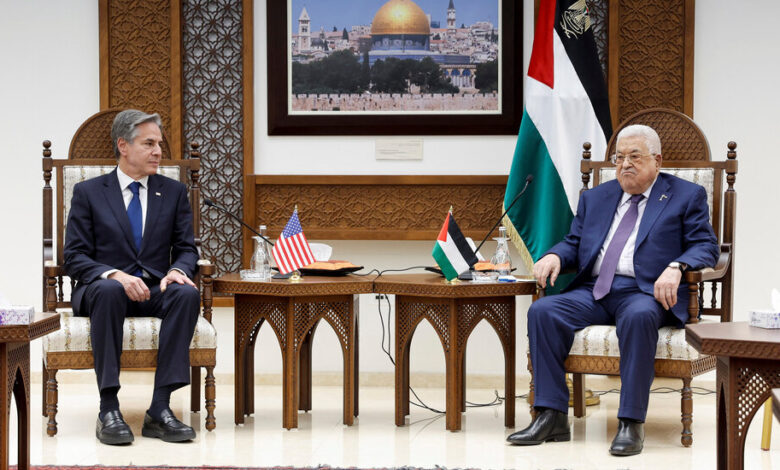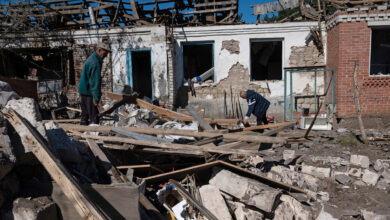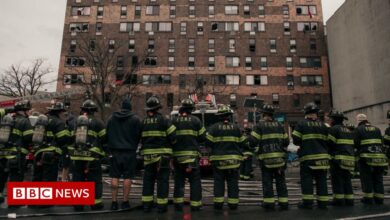Israel-Hamas War News: Blinken Visits the Israeli-Occupied West Bank

The wall of a school had shattered into rubble. The minaret of a mosque was tilting to one side. The roof of a beachfront villa had vanished, leaving a maroon sofa exposed to the elements.
Along the northern coastline of Gaza on Saturday afternoon, these were the signs of battle between Hamas, the Palestinian militia that controls the Gaza Strip, and the Israeli army, which had for eight days tried to oust Hamas from power.
Israeli military leaders took a small group of foreign journalists into northern Gaza on Saturday for four hours to witness the extent of the advance. A reporter for The New York Times was among them.
Thousands of troops began their incursion down the coastline on Oct. 27, one part of a three-pronged invasive force that aims to vanquish Hamas, which led a brazen raid on Israel last month that killed roughly 1,400 people.
Eight days later, the Israeli army has fought its way several miles to the south, reaching the outskirts of Gaza City, Hamas’s stronghold, and establishing control over the northern stretch of Gaza’s coastal road.
Less than a month ago, the northern coastline of Gaza was a quiet seafront flecked here and there with beach resorts and hotels. On Saturday, it was a giant Israeli military camp.
Long lines of infantry marched south along the road, blowing plumes of dust into the air. In the sand dunes east of the road, long rows of tanks and armored vehicles dominated the landscape, stretching toward the horizon.
Many buildings were wrecked, their walls sprayed with bullet holes. Some were most likely hit from the air during an Israeli bombing campaign that has killed more than 9,000 Gazans, according to Gaza’s health authority, which is controlled by Hamas.
Palestinian residents had fled south, abandoning the seafront to the Israeli soldiers and a few stray dogs and cats.
An Israeli officer accompanying the journalists, Lt. Col. Iddo Ben-Anat, projected an image of quiet confidence.
Hamas had been routed here, the colonel said, forced out from its bases in the mosque with the tilting minaret and the school with the shattered wall.
“It’s like catching a mouse,” Colonel Ben-Anat said of the enemy. “You have to find him. You know he’s there. You don’t know where he is — but you know when you catch him, he’s done.”
Nearby, groups of soldiers gathered around portable camping stoves, boiling sweet corn and carrots, chatting and joking. Several sported well-groomed mustaches — an incongruous nod to Movember, an annual global fund-raising campaign in which men grow mustaches throughout the month of November.
All of the political divisions in Israel of the past year — in which thousands of military reservists had threatened to refuse to serve in protest of the Israeli government — had vanished, the colonel said. Many of his men were reservists.
“United, together,” said Colonel Ben-Anat.
But drowning out these expressions of bravado were the sounds of an unfinished and undecided war.
Even as some soldiers cooked and rested, others had their guns drawn, scanning the horizon for assailants. At any moment, the colonel said, Hamas fighters might emerge from hidden shafts that lead to a vast underground tunnel network, hundreds of miles along, and ambush the Israeli troops.
Gunfire rattled constantly, and munitions flew regularly overhead.
In order to enter Gaza, a reporter for The New York Times was obliged to remain with Israeli troops for the duration of the visit and agreed not to photograph either the inside of the vehicle in which reporters traveled or a landmark that would have identified the Israeli military position that the reporters visited. The Times did not allow the Israeli military to screen its coverage before publication.
Shortly after the journalists entered Gaza through a hole in the wall lining its perimeter, a mortar shell landed close to the armored vehicle that carried them south.
A few minutes later, a roadside bomb exploded as the vehicle passed by, creating a brief fireball and sending sand toward the sky.
Another barrage of mortar shells landed near the journalists after they got closer to the front line.
To reach the front, the journalists drove in a convoy of five tanks and two armored vehicles. A reporter for The Times traveled in an armored vehicle known as an Eitan. It had no windows: To see his surroundings, the driver looked at a digital screen that showed a live video of the road ahead.
Palestinian journalists have not had such protection; dozens have been killed in airstrikes since the start of the war, according to the Committee to Protect Journalists.
To truly rout Hamas, Israel will need to capture all of Gaza, the colonel said.
Bloodier battles await the Israelis in Gaza City, where Hamas fighters are entrenched in their subterranean fortifications and are thought to be planning many more ambushes.
Analysts say that such fighting could cause catastrophic civilian losses — an outcome Israel says it is trying to avoid.
“We do our best to destroy Hamas only, without harming the civilians,” said Colonel Ben-Anat. “We’ll think 10 times before we do something.”
But for the civilians in Gaza City, who have witnessed one of the most intense bombing campaigns of the 21st century, the Israeli army’s approach is terrifying.
Saher Abu Adgham, 37, a Palestinian graphic designer, had been searching the streets of Gaza City for firewood to boil some rice. As dusk approached, he bedded down at home in case the army advanced at nightfall.
“I am afraid to go out one night and meet a tank,” Mr. Abu Adgham said in a phone interview.
With mobile networks often out of service, other residents of Gaza City were trying to assess the Israeli advance by listening to the sound of the gunfire.
“We don’t have internet to listen to the news and know what is happening — but we can hear it,” said Majdi Ahmed, 32, a taxi driver taking shelter in a hospital in the city.
“Now I can hear the shooting,” Mr. Ahmed said in a voice message. “Seems they are now fighting.”
Iyad Abuheweila contributed reporting from Cairo, Abu Bakr Bashir from London and Patrick Kingsley from Jerusalem.




